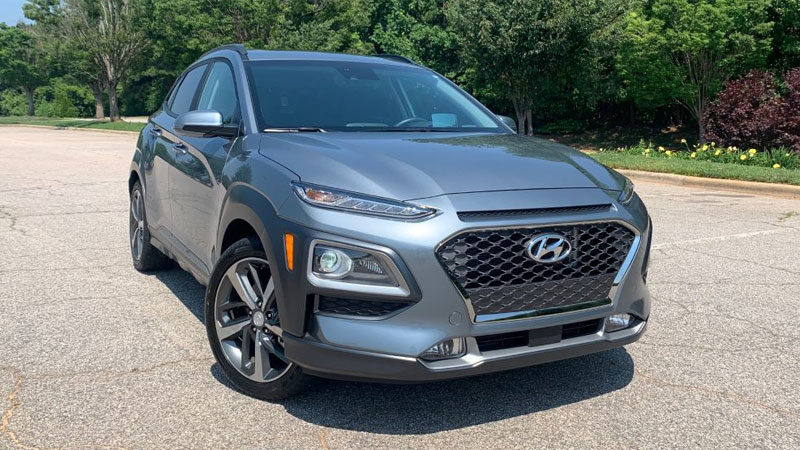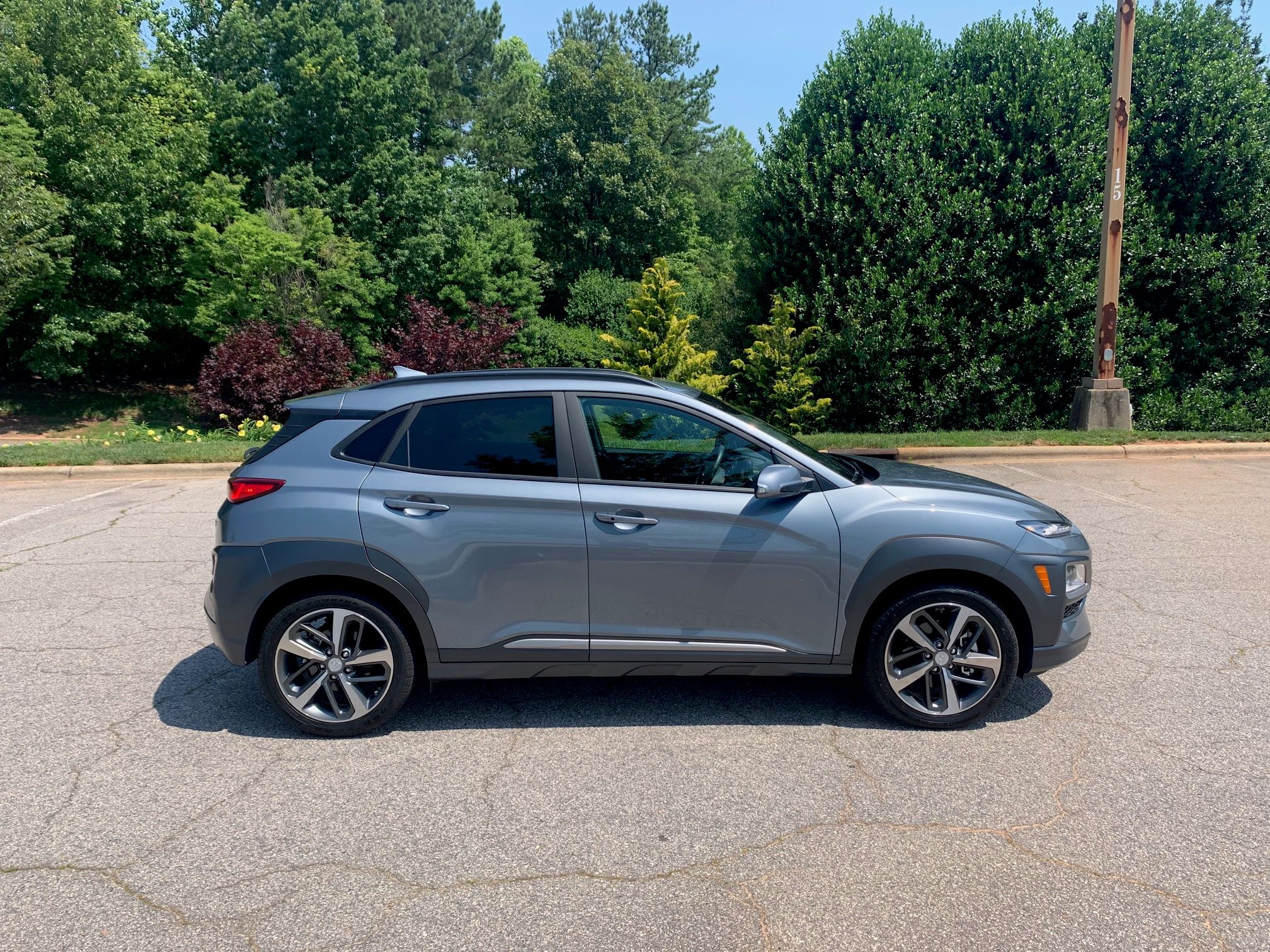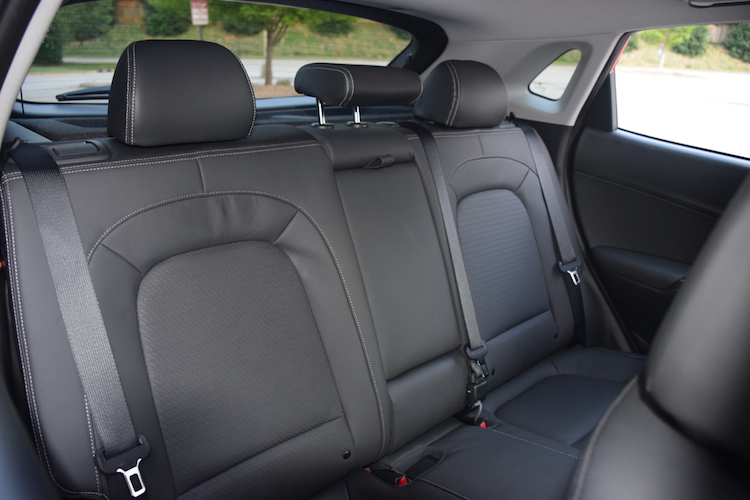On the road with Hyundai’s almost smallest utility vehicle.
Hyundai’s utility vehicle portfolio is one of the newest on the market, composed of multiple models spanning from the diminutive Venue to the roomy and luxurious Palisade. One of its smallest models is the Kona, a subcompact model with room for five. It delivers style, amenities, and performance that punches above its weight.
2020 Hyundai Kona Review
Hyundai offers the 2020 Kona in SE ($20,300), SEL ($22,100), SEL Plus ($23,950), Limited ($26,100), and Ultimate ($27,950) trims.
All trims come with standard front-wheel drive. All-wheel drive is a $1,400 upgrade. You’ll find two engine choices; each works with an automatic transmission.
For 2020, Hyundai did the usual equipment shuffling. Adaptive cruise control is now standard on the top Ultimate trim.
See Also – 2022 Hyundai Kona N Review
Exterior
We’ve noticed a trend from Hyundai over the past 10 years: design cars with a premium look, while maintaining a mainstream price. That strategy has worked well for the automaker as its various “fluidic” designs have won much praise.
Hyundai’s current design strategy is evident in vehicles such as the Kona, Sonata, and Palisade. The look includes a large grille, sporty headlights, beautiful accent lights, generous body sculpting, and exquisite lines. Most definitely the Kona is dressed with distinction.
Hyundai equips the Kona with an impressive list of standard features, including automatic on/off headlights, LED daytime running lights, and a rear spoiler with a center LED brake light.
Starting with the SEL trim, the Kona gains heated side mirrors with turn signal indicators, roof side rails, and an anti-theft vehicle immobilizer. The SEL Plus adds front fog lights and a power tilt-and-slide sunroof.
The Kona gets every available feature with the Limited, except the rain-sensing wipers on the Ultimate. Here, the Limited gains upgraded exterior trim, including cascading grille with chrome grille surround. Also standard are aero wiper blades, LED headlights with low beam assist, and LED taillights.
As for wheel choices, the SE comes with 16-inch alloy wheels. The SEL and SEL Plus have 17-inch alloy wheels, while the 18-inch alloy wheels are reserved for the Limited and Ultimate trims. Optionally, Hyundai supplies a contrasting roof option beginning with SEL trim.
Interior
We like the Kona’s cabin, although it is a stretch to say it seats five. There is a quintet of safety belts present, but this model likely will appeal to two adults with the occasional rear passengers present. Even then, the rear space is small and best allocated for two children. Better yet, fold down the rear seat and extend your cargo space appreciably.
Kudos to Hyundai for delivering an interior that uses high-quality material and lays them with precision throughout. There’s nothing that looks cheap here.
The standard Kona comes with keyless entry with an alarm; push-button start rolls out at the SEL level. Full power accessories, a tilt-and-telescopic steering column, air conditioning, cloth seats, and a 60/40 split fold-down rear seat are standard.
At the SEL trim, Hyundai includes a leather-wrapped steering wheel and shift knob, heated front seats, dual-illuminated visors, and a hidden cargo-area storage compartment. The SEL Plus brings in an 8-way power driver’s seat with power lumbar support and an automatic dimming rearview mirror with HomeLink.
Choose the Limited and this trim gains leather-trimmed seats and automatic temperature control. If you want a head’s up display, this feature is exclusive to the Ultimate.
Safety
Hyundai does a good job by supplying the driver-assist safety features we’re accustomed to these days. Under the SmartSense Advanced Safety umbrella, the Kona has standard forward collision-avoidance assist, lane-keeping assist, and driver-attention warning.
The SEL trim builds on this, gaining blind-spot collision warning with lane change assist and rear cross-traffic alert. No additional features are included until you choose the top Ultimate trim.
Specifically, Hyundai includes high-beam assist, pedestrian detection with forward collision warning, park distance warning, and smart cruise control.
Technology
We like Hyundai’s tech features especially beginning with the SEL Plus trim.
A 7-inch touch-screen display is standard. Moreover, Apple CarPlay and Android Auto smartphone compatibility, two USB ports, and an auxiliary input jack are included.
Moving up to the SEL trim adds satellite and HD Radio. The SEL Plus swaps out the standard audio system with an 8-speaker Infinity package. The big surprise and a nice feature typically reserved for top-trim models (if available at all) is a wireless device charging pad. Furthermore, with this trim, the Kona also gains Hyundai’s Blue Link suite of connected services.
The Limited adds no features, while the Ultimate has the 8-inch touch-screen display with navigation. You certainly don’t need navigation as smartphone compatibility is enough.
Performance
The optional turbo engine is more powerful and efficient than the base driver. We see this from time to time as a manufacturer offers a standard engine, then tantalizes with an optional engine that’s usually a better choice. It’s standard on the two top trims, while the base engine motivates the first three trims.
Our test model had the optional turbocharged 1.6-liter four-cylinder engine. This one makes an impressive 175 horsepower and 195 pound-feet of trim. Compare these numbers to the 2.0-liter four-cylinder engine’s 147 horsepower and 132 pound-feet of torque and it quickly becomes apparent that the differences are significant.
Both engines work with an automatic transmission: the standard engine is paired with a 6-speed automatic; the turbo has a 7-speed dual-clutch transmission.
We found the turbo is a competent motivator, although we noticed some lag before the engine was warm. This isn’t uncommon, but it’s something to keep in mind if you plan to floor it soon after start.
Once spooled, the Kona moves with authority. It’s the engine choice for anyone who wants something beyond the leisurely standard motivator.
You’ll also average no better than 28 mpg compared to the 30 mpg of the turbo.
The Kona is fun to drive with spot-on steering and nimble handling. It may be a “high profile” vehicle, but its diminutive size keeps most incidences of body roll in check. We found the Kona surprisingly fun on curvy roads, although you’ll need to keep it slow when pulling out of corners.
If you’re performance-minded, either the Hyundai Tiburon or Hyundai Elantra GT are the better choices.
Competitive Set
The subcompact crossover utility vehicle segment is booming as it offers an affordable entry point into the market. Hyundai has two choices – the Kona and the even smaller Venue. The Venue, however, does not offer all-wheel drive.
Among the competitors in this segment are the Fiat 500X, Jeep Renegade, Ford EcoSport, Chevrolet Trax, Toyota C-HR, and the Honda HR-V. Other models include the Nissan Kicks and Rogue Sport, Mazda CX-3 and CX-30, Mitsubishi Outlander Sport, and the Subaru Crosstrek.
Like the Venue, the C-HR and Kicks are front-wheel-drive only. All other models except the Subaru offer available all-wheel drive. Only the Crosstrek is imbued with standard all-wheel drive.
Our Recommendation
If you’re on a budget, the base model certainly has its appeal. But we’d step up to at least the SEL to obtain some of the better amenities offered. Of course, it’s hard to ignore the turbo engine, which is only available on the top trims.
If the engine appeals to you and you can live without all the advanced driver safety features available with the Ultimate trim, then go with the Kona Limited.
All in all, the Hyundai Kona does what it needs to do to attract consumers, including those moving over from a sedan. The competition is stiff, but Hyundai doesn’t back down with either of its tiniest utility vehicles.
2020 Hyundai Kona Specifications
| Hyundai | 2020 Kona |
|---|---|
| Segment | Subcompact SUV |
| Price Range | $20,300 to $27,950 |
| Destination Charge | $1,140 |
| Engine No. 1 | 2.0-liter, I4 |
| Horsepower | 147 @ 6,200 rpm |
| Torque (lb.-ft.) | 132 @ 4,500 rpm |
| Transmission | 6-speed automatic |
| Engine No. 2 | 1.6-liter, I4 |
| Horsepower | 175 @ 5,500 rpm |
| Torque (lb.-ft.) | 195 @ 1,500-4,500 rpm |
| Transmission | 7-speed DCT |
| Seating | 5 |
| Curb Weight (pounds) | 2,890 to 3,126 |
| Wheelbase (inches) | 102.4 |
| Length (inches) | 164.0 |
| Width (inches) | 70.9 |
| Height (inches) | 61.0 |
| Headroom (f,r…inches) | 39.6, 37.8 |
| Legroom (f,r…inches) | 41.5, 34.6 |
| Shoulder room (f,r…inches) | 55.5, 54.5 |
| Hip room (f,r…inches) | 53.3, 52.2 |
| Storage (cubic feet) | 19.2, 45.8 |
| Gross vehicle weight (pounds) | 3,979 to 4,189 |
| Towing (pounds) | NR |
| Payload (pounds) | NR |
| Fuel | regular |
| Fuel Tank (gallons) | 13.2 |
| EPA Fuel MPG (city/highway/combined) | 27/33/30 |
| Manufacturing Plant | NR |
Data compiled by Tom Keegan. Specifications supplied by the manufacturer.
See Also – Budget Crossover: 2020 Hyundai Venue
Photos copyright Auto Trends Magazine. All rights reserved.
- 2024 Mazda CX-50: A Compact SUV with Premium Aspirations - Apr 15, 2024
- 2024 Ford Mustang (Iconic Pony Car Evolves) - Apr 4, 2024
- 2024 Ford Maverick (Looks Like a Truck, Drives Like a Car) - Mar 28, 2024






